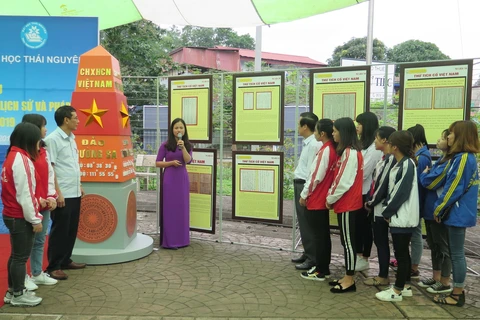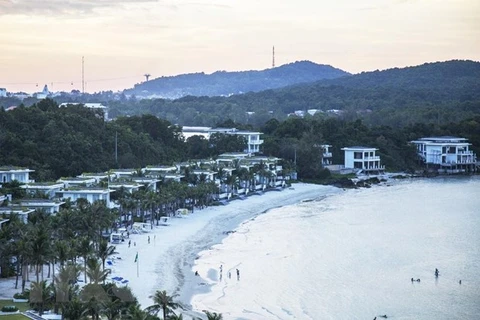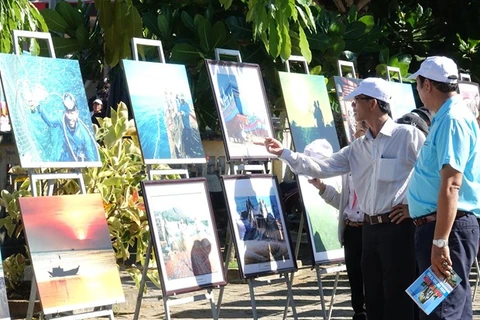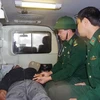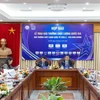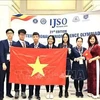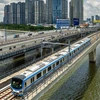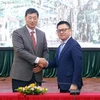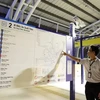Hanoi (VNA) – Truong Sa (Spratly) archipelago is no longer a group of “lonely” and barren islands, but a place greened with the colour of vitality, trust and hope.
In early May this year, VietnamPlus reporters and nearly 200 delegates from central agencies and localities across the nation had a visit to soldiers and islanders inn Truong Sa island district and on DK1 Platform, who are firmly safeguarding the sacred national sovereignty.
Arriving in Truong Sa, we were impressed to find that suffering 131 stormy days each year and 13-20 days of strong winds, yet the land could be that green, the green of vitality, trust and hope.
Vegetables remain green, flowers keep blossoming
Truong Sa island district is no longer a lonely place, but one that all Vietnamese people wish to visit.
On all islands of the district, herds of chickens and ducks were seeking their foodon the beach, green vegetable gardens were growing, and lines of trees formed a “green dyke” to break the waves. The peaceful made usthink this is a rural area on the mainland.
Growing vegetables to … ease homesick
Cam Ranh port in early May was covered by strong sunlight. We departed at 17:00 on Fisheries Resources Surveillance Vessel KN 491 to head to islands of Truong Sa archipelago and DK1 Platform, realizing our wish to touch part of the nation’s “skin and flesh”.
After 36 hours of sailing through more than 300 nautical miles, we could not maintain balance. However, upon seeing the building on the Da Lon island, surrounded by green vegetable gardens under the flying national flag, our tiredness was replaced with excitement.
Landing on the island, the first thing we saw was the marker of the national sovereignty, safeguarded by a soldier with his gun in his hands. The barrack of the soldiers was built on the foundation of rock and coral under the water. But the efforts of the soldiers brought a new vitality to the island. They raised poultry and pigs on the island. The green vegetables kept growing and the flowers blossoming on the rocks amidst the sea.
In the difficult conditions, Truong Sa soldiers still firmly safeguard the national sky and sea, while taking their time to conserve fresh water and cultivate vegetables, raise poultry and catch fish, thus providing themselves with fresh foodstuff.
A soldier told us that in order to ease homesick, they brought the popular vegetable varieties from their hometown to grow on the island. Each surviving vegetable is a great happiness and hope for the soldiers.
In the severe shortage of fresh water, the growing of the green gardens needed great efforts. The vegetables were carefully covered to avoid strong winds and sea waves, or grown in boxes.
 Rear Admiral Pham Van Luyen, Deputy Political Commissar of the People’s Navy (first left) visits the vegetable garden on An Bang, which produced 6 tonnes of vegetables in 2018 (Photo: VietnamPlus).
Rear Admiral Pham Van Luyen, Deputy Political Commissar of the People’s Navy (first left) visits the vegetable garden on An Bang, which produced 6 tonnes of vegetables in 2018 (Photo: VietnamPlus). According to Nguyen Hong Tien, Political Commissar of An Bang island, the growing of vegetable on the islands was difficult as soil, fertilizers andseeds must be provided from the mainland. Fresh water was scarce, while rain water was mostly used for drinking and cooking.
In that condition, the soldiers though about reusing the water for watering the garden, ensuring water for the vegetables, he said.
Tien noted that in 2018, the island produced 6 tonnes of vegetables, becoming a model even for other units in the mainland to follow.
The emulation in the island was practical. The soldiers followed the example of President Ho Chi Minh by growing vegetables and breeding poultry. All of the soldiers were always optimistic and maintained absolute trust in the leadership of the Party and State as well as the navy.
“Green capital” at sea
During the 9-day journey to Truong Sa through 10 islands and DK1 Platform in the southern continental shelf, the most impressive thing to me was the Truong Sa Lon island, dubbed the “green capital” of the archipelago. The island was covered by green colour from “bang vuong” (square-fruit Malabar Almond) trees, creating a beautiful picture.
Bang vuong is a kind of tree with square fruits which turn purple when they are riped.
 “Bang vuong” (square-fruit Malabar Almond) flowers are considered the “queen beauty” of Truong Sa. (Photo: VietnamPlus)
“Bang vuong” (square-fruit Malabar Almond) flowers are considered the “queen beauty” of Truong Sa. (Photo: VietnamPlus) Currently, “bang vuong” trees have been planted widely on many islands in Truong Sa, manyrecognised as Vietnam’s heritage trees. The unique thing of the trees is their resilience in tough weather conditions and the good smell of the flowers, especially at night.
Along with the “specialty” trees of “bang vuong” and phong ba (Old-aged Heliotropiumfoertherianum), the island also had other fruit trees brought from the mainland such as tamarind, mango, jackfruit, guava, papaya, tamanu and coconut. Particularly, the 125-year-old tamanu tree on the island has been recognised as the heritage tree.
Pointing to the green bamboos, Vice Commander of Truong Sa islandDinhTrongTham said that initially, there were several trees brought by the soldiers. The trees then spread to big groups and grew in many corners of the island. There shade created resting places for cows which eat the leaves of the bamboos. The bodies of the bamboos are used to make rattan products, while bamboo shoots can be used as food, he added./.


